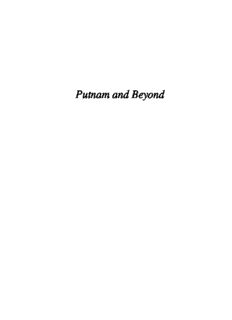Table Of ContentPutnam and Beyond
Ra˘zvan Gelca
Titu Andreescu
Putnam and Beyond
Ra˘zvanGelca TituAndreescu
TexasTechUniversity UniversityofTexasatDallas
DepartmentofMathematicsandStatistics SchoolofNaturalSciencesandMathematics
MA229 2601NorthFloydRoad
Lubbock,TX79409 Richardson,TX75080
USA USA
[email protected] [email protected]
CoverdesignbyMaryBurgess.
LibraryofCongressControlNumber:2007923582
ISBN-13:978-0-387-25765-5 e-ISBN-13:978-0-387-68445-1
Printedonacid-freepaper.
(cid:1)c2007SpringerScience+BusinessMedia,LLC
All rights reserved. This work may not be translated or copied in whole or in part without the written permission
ofthepublisher(SpringerScience+BusinessMediaLLC,233SpringStreet,NewYork,NY10013,USA)andthe
author,exceptforbriefexcerptsinconnectionwithreviewsorscholarlyanalysis.Useinconnectionwithanyformof
informationstorageandretrieval,electronicadaptation,computersoftware,orbysimilarordissimilarmethodology
nowknownorhereafterdevelopedisforbidden.
Theuseinthispublicationoftradenames,trademarks,servicemarksandsimilarterms,eveniftheyarenotidentified
assuch,isnottobetakenasanexpressionofopinionastowhetherornottheyaresubjecttoproprietaryrights.
9 8 7 6 5 4 3 2 1
springer.com (JLS/HP)
Lifeisgoodforonlytwothings,discovering
mathematicsandteachingmathematics.
SiméonPoisson
Contents
Preface ............................................................ xi
AStudyGuide ...................................................... xv
1 MethodsofProof ................................................ 1
1.1 ArgumentbyContradiction ...................................... 1
1.2 MathematicalInduction ......................................... 3
1.3 ThePigeonholePrinciple........................................ 11
1.4 OrderedSetsandExtremalElements .............................. 14
1.5 InvariantsandSemi-Invariants ................................... 19
2 Algebra ........................................................ 25
2.1 IdentitiesandInequalities ....................................... 25
2.1.1 AlgebraicIdentities....................................... 25
2.1.2 x2 ≥ 0.................................................. 28
2.1.3 TheCauchy–SchwarzInequality............................ 32
2.1.4 TheTriangleInequality ................................... 36
2.1.5 TheArithmeticMean–GeometricMeanInequality............. 39
2.1.6 Sturm’sPrinciple......................................... 42
2.1.7 OtherInequalities ........................................ 45
2.2 Polynomials................................................... 45
2.2.1 AWarmup .............................................. 45
2.2.2 Viète’sRelations ......................................... 47
2.2.3 TheDerivativeofaPolynomial............................. 52
2.2.4 TheLocationoftheZerosofaPolynomial ................... 54
2.2.5 IrreduciblePolynomials ................................... 56
2.2.6 ChebyshevPolynomials ................................... 58
viii Contents
2.3 LinearAlgebra................................................. 61
2.3.1 OperationswithMatrices .................................. 61
2.3.2 Determinants ............................................ 63
2.3.3 TheInverseofaMatrix ................................... 69
2.3.4 SystemsofLinearEquations ............................... 73
2.3.5 VectorSpaces,LinearCombinationsofVectors,Bases ......... 77
2.3.6 LinearTransformations,Eigenvalues,Eigenvectors ............ 79
2.3.7 TheCayley–HamiltonandPerron–FrobeniusTheorems ........ 83
2.4 AbstractAlgebra ............................................... 87
2.4.1 BinaryOperations........................................ 87
2.4.2 Groups ................................................. 90
2.4.3 Rings .................................................. 95
3 RealAnalysis ................................................... 97
3.1 SequencesandSeries ........................................... 98
3.1.1 SearchforaPattern....................................... 98
3.1.2 LinearRecursiveSequences ............................... 100
3.1.3 LimitsofSequences ...................................... 104
3.1.4 MoreAboutLimitsofSequences ........................... 111
3.1.5 Series .................................................. 117
3.1.6 TelescopicSeriesandProducts ............................. 120
3.2 Continuity,Derivatives,andIntegrals ............................. 125
3.2.1 LimitsofFunctions....................................... 125
3.2.2 ContinuousFunctions..................................... 128
3.2.3 TheIntermediateValueProperty............................ 131
3.2.4 DerivativesandTheirApplications.......................... 134
3.2.5 TheMeanValueTheorem ................................. 138
3.2.6 ConvexFunctions ........................................ 142
3.2.7 IndefiniteIntegrals ....................................... 147
3.2.8 DefiniteIntegrals......................................... 150
3.2.9 RiemannSums .......................................... 153
3.2.10 InequalitiesforIntegrals................................... 156
3.2.11 TaylorandFourierSeries .................................. 159
3.3 MultivariableDifferentialandIntegralCalculus..................... 167
3.3.1 PartialDerivativesandTheirApplications.................... 167
3.3.2 MultivariableIntegrals .................................... 174
3.3.3 TheManyVersionsofStokes’Theorem...................... 179
3.4 EquationswithFunctionsasUnknowns............................ 185
3.4.1 FunctionalEquations ..................................... 185
3.4.2 OrdinaryDifferentialEquationsoftheFirstOrder ............. 191
Contents ix
3.4.3 OrdinaryDifferentialEquationsofHigherOrder .............. 195
3.4.4 ProblemsSolvedwithTechniquesofDifferentialEquations ..... 198
4 GeometryandTrigonometry ...................................... 201
4.1 Geometry..................................................... 201
4.1.1 Vectors ................................................. 201
4.1.2 TheCoordinateGeometryofLinesandCircles................ 206
4.1.3 ConicsandOtherCurvesinthePlane........................ 212
4.1.4 CoordinateGeometryinThreeandMoreDimensions .......... 219
4.1.5 IntegralsinGeometry..................................... 225
4.1.6 OtherGeometryProblems ................................. 228
4.2 Trigonometry.................................................. 231
4.2.1 TrigonometricIdentities ................................... 231
4.2.2 Euler’sFormula.......................................... 235
4.2.3 TrigonometricSubstitutions................................ 238
4.2.4 TelescopicSumsandProductsinTrigonometry ............... 242
5 NumberTheory ................................................. 245
5.1 Integer-ValuedSequencesandFunctions........................... 245
5.1.1 SomeGeneralProblems................................... 245
5.1.2 Fermat’sInfiniteDescentPrinciple.......................... 248
5.1.3 TheGreatestIntegerFunction .............................. 250
5.2 Arithmetic .................................................... 253
5.2.1 FactorizationandDivisibility .............................. 253
5.2.2 PrimeNumbers .......................................... 254
5.2.3 ModularArithmetic....................................... 258
5.2.4 Fermat’sLittleTheorem................................... 260
5.2.5 Wilson’sTheorem........................................ 264
5.2.6 Euler’sTotientFunction................................... 265
5.2.7 TheChineseRemainderTheorem........................... 268
5.3 DiophantineEquations.......................................... 270
5.3.1 LinearDiophantineEquations .............................. 270
5.3.2 TheEquationofPythagoras................................ 274
5.3.3 Pell’sEquation .......................................... 276
5.3.4 OtherDiophantineEquations............................... 279
6 CombinatoricsandProbability .................................... 281
6.1 CombinatorialArgumentsinSetTheoryandGeometry............... 281
6.1.1 SetTheoryandCombinatoricsofSets ....................... 281
6.1.2 Permutations ............................................ 283
6.1.3 CombinatorialGeometry .................................. 286
x Contents
6.1.4 Euler’sFormulaforPlanarGraphs .......................... 289
6.1.5 RamseyTheory .......................................... 291
6.2 BinomialCoefficientsandCountingMethods....................... 294
6.2.1 CombinatorialIdentities................................... 294
6.2.2 GeneratingFunctions ..................................... 298
6.2.3 CountingStrategies....................................... 302
6.2.4 TheInclusion–ExclusionPrinciple .......................... 308
6.3 Probability .................................................... 310
6.3.1 EquallyLikelyCases ..................................... 310
6.3.2 EstablishingRelationsAmongProbabilities .................. 314
6.3.3 GeometricProbabilities ................................... 318
Solutions
MethodsofProof.................................................... 323
Algebra............................................................ 359
RealAnalysis ....................................................... 459
GeometryandTrigonometry.......................................... 603
NumberTheory..................................................... 673
CombinatoricsandProbability ........................................ 727
IndexofNotation ................................................... 791
Index.............................................................. 795
Preface
Aproblembookatthecollegelevel. AstudyguideforthePutnamcompetition. Abridge
betweenhighschoolproblemsolvingandmathematicalresearch. Afriendlyintroduction
tofundamentalconceptsandresults. Allthesedesiresgavelifetothepagesthatfollow.
TheWilliamLowellPutnamMathematicalCompetitionisthemostprestigiousmath-
ematics competition at the undergraduate level in the world. Historically, this annual
event began in 1938, following a suggestion of William Lowell Putnam, who realized
themeritsofanintellectualintercollegiatecompetition. Nowadays,over2500students
frommorethan300collegesanduniversitiesintheUnitedStatesandCanadatakepart
in it. The name Putnam has become synonymous with excellence in undergraduate
mathematics.
UsingthePutnamcompetitionasasymbol, welaythefoundationsofhighermath-
ematics from a unitary, problem-based perspective. As such, Putnam and Beyond is a
journey through the world of college mathematics, providing a link between the stim-
ulating problems of the high school years and the demanding problems of scientific
investigation. Itgivesmotivatedstudentsachancetolearnconceptsandacquirestrate-
gies,honetheirskillsandtesttheirknowledge,seekconnections,anddiscoverrealworld
applications. Itsultimategoalistobuildtheappropriatebackgroundforgraduatestudies,
whetherinmathematicsorappliedsciences.
Ourpointofviewisthatinmathematicsitismoreimportanttounderstandwhythan
toknowhow. Becauseofthisweinsistonproofsandreasoning. Afterall,mathematics
means, as the Romanian mathematician Grigore Moisil once said, “correct reasoning.’’
Thewaysofmathematicalthinkingareuniversalintoday’sscience.
Putnam and Beyond targets primarily Putnam training sessions, problem-solving
seminars,andmathclubsatthecollegelevel,fillingagapintheundergraduatecurriculum.
But it does more than that. Written in the structured manner of a textbook, but with
strongemphasisonproblemsandindividualwork,itcoverswhatwethinkarethemost
importanttopicsandtechniquesinundergraduatemathematics,broughttogetherwithin
the confines of a single book in order to strengthen one’s belief in the unitary nature of
xii Preface
mathematics. Itisassumedthatthereaderpossessesamoderatebackground,familiarity
withthesubject,andacertainlevelofsophistication,forwhatwecoverreachesbeyond
theusualtextbook,bothindifficultyandindepth. Whenorganizingthematerial,wewere
inspired by Georgia O’Keeffe’s words: “Details are confusing. It is only by selection,
byelimination,byemphasisthatwegetattherealmeaningofthings.’’
The book can be used to enhance the teaching of any undergraduate mathematics
course, since it broadens the database of problems for courses in real analysis, linear
algebra, trigonometry, analytical geometry, differential equations, number theory, com-
binatorics,andprobability. Moreover,itcanbeusedbygraduatestudentsandeducators
aliketoexpandtheirmathematicalhorizons,formanyconceptsofmoreadvancedmath-
ematicscanbefoundheredisguisedinelementarylanguage,suchastheGauss–Bonnet
theorem, the linear propagation of errors in quantum mechanics, knot invariants, or the
Heisenberg group. The way of thinking nurtured in this book opens the door for true
scientificinvestigation.
As for the problems, they are in the spirit of mathematics competitions. Recall that
the Putnam competition has two parts, each consisting of six problems, numberedA1
throughA6,andB1throughB6. Itiscustomarytolisttheproblemsinincreasingorder
ofdifficulty,withA1andB1theeasiest,andA6andB6thehardest. Wekeepthesame
ascending pattern but span a range fromA0 to B7. This means that we start with some
inviting problems below the difficulty of the test, then move forward into the depths of
mathematics.
As sources of problems and ideas we used the Putnam exam itself, the Interna-
tionalCompetitioninMathematicsforUniversityStudents,theInternationalMathemat-
ical Olympiad, national contests from the United States of America, Romania, Rus-
sia, China, India, Bulgaria, mathematics journals such as the American Mathemati-
cal Monthly, Mathematics Magazine, Revista Matematica˘ din Timis¸oara (Timis¸oara
Mathematics Gazette), Gazeta Matematica˘ (Mathematics Gazette, Bucharest), Kvant
(Quantum),Ko˝zépiskolaiMatematikaiLapok(MathematicalMagazineforHighSchools
(Budapest)), and a very rich collection of Romanian publications. Many problems are
original contributions of the authors. Whenever possible, we give the historical back-
groundandindicatethesourceandauthoroftheproblem. Someofoursourcesarehard
tofind;thisiswhyweofferyoutheirmostbeautifulproblems. Othersourcesarewidely
circulated, and by selecting some of their most representative problems we bring them
toyourattention.
Hereisabriefdescriptionofthecontentsofthebook. Thefirstchapterisintroductory,
giving an overview of methods widely used in proofs. The other five chapters reflect
areasofmathematics: algebra,realanalysis,geometryandtrigonometry,numbertheory,
combinatoricsandprobability. Theemphasisisplacedonthefirsttwoofthesechapters,
sincetheyoccupythelargestpartoftheundergraduatecurriculum.
Withineachchapter,problemsareclusteredbytopic. Wealwaysofferabrieftheoret-
icalbackgroundillustratedbyoneormoredetailedexamples. Severalproblemsareleft
Description:There are many books on problem solving. The majority are aimed at junior high and high school students preparing for either the International Mathematical Olympiad or national IMO selection tests (the American Mathematics Contests in the United States, such as the USAMO). A select few, such as Prob

